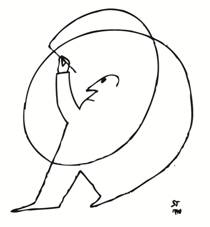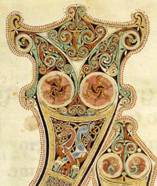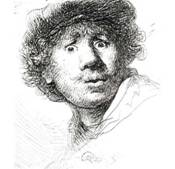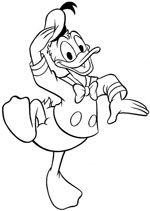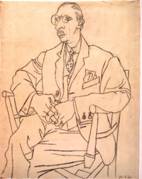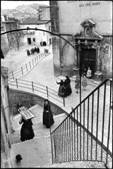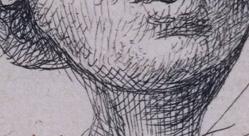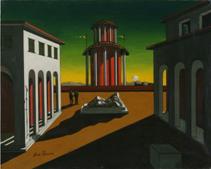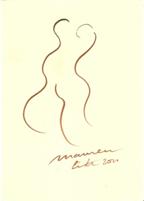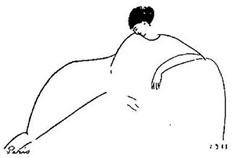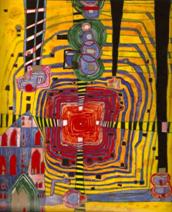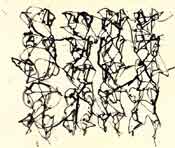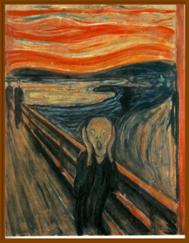Line
A line is a path left by a moving point, it is a mark or stroke that is long in proportion to its width. Lines are fundamental elements used in design. They can act as a symbolic language, or they can communicate emotion through their character and direction.
TYPES OF LINES
Actual line
A visible mark made by a pencil or paint or any other medium. ![]()
Psychic LineThere is no real line yet we feel a line... Da Vinci's Last Supper |
|
 |
|
For example, eyes looking in a direction... a hand pointing in a direction. |
|
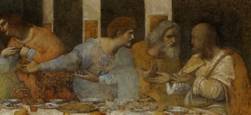 |
|
Shape boundary or edge
| The edge of a shape or solid object reads as a line. | |
|
František Kupka |
 |
Implied Line
| A series of dots (or other marks) can read as a line as in this close up of a mosaic. |
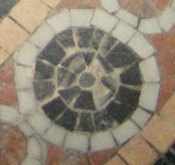 |
FUNCTIONS OF LINE
Lines can function independently |
|
|
Saul Steinberg |
Lines can define a shape
Outline
An outline is a line which marks the outer limits of an object or figure; the exterior line, boundary or edge. |
|
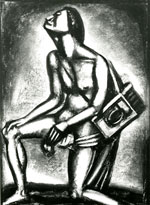 Georges Roualt Georges Roualt |
|
Contour
| A contour is a line that defines or bounds anything -- defines its edge. Most lines in art are contour lines. An object does not have a line around its edge, nor anything that looks like a line. Yet when you see a line drawing you have no trouble interpreting the image as representing something in the real world. There are more contours on any complex object than just the outside edge. More subtle contours like folds and color changes can be represented by contour lines… anything that appears to have an edge. |
|
| Pablo Picasso "Stravinsky" |
Lines can divide space
Movement
| The lines streaking behind the drawing of a car imply motion… as do the lines in Balla’s “Car Fetish” painting | |||
 |
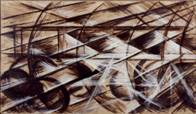 |
||
Emphasis
| Lines can emphasize the direction of eye movement in an image… or they can demand more attention than another part of the image. |
Henri Cartier-Bresson |
Texture
| Notice the use of line to create the texture of Rembrandt’s hair and fur collar. |
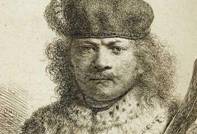 |
Shading
Decoration
| There are many ways line can be used to decorate. Linear shapes and/or patterns decorate many objects. |
|
| Fabrics and wrapping paper.  |
Even natural surfaces like wood grain |
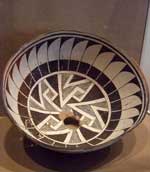 Mimbres Pottery Mimbres Pottery |
|
| "The Mimbres occupied the somewhat isolated mountain and river valleys of southwestern New Mexico from about 1000 to 1250 AD." "...the deceased were buried in an upright crouched position with a bowl (often, but not always painted) placed over their heads. The decorated bowls were “killed” through the use of a sharp object, which served to pierce a hole in the bottom of the vessel. Archaeologist J.J. Brody suggests that the act of piercing the bowl and placing it over the head of the deceased allowed the spirit of the dead to escape the body." ~ http://anthropology.si.edu/cm/mimbres.htm |
LINE DIRECTION
Horizontal lines seem placid and stable |
Kenneth Nolan
|
|
Arundel cathedral interior |
Vertical lines are also stable, but lend an upward thrust to the image, often conveying a feeling of loftiness and spirituality |
| Diagonal lines imply action. |
Rubens "Elevation" |
|
De Chirico "Italian Square" |
Diagonal lines can also be used to indicate depth. |
LINE QUALITY
|
|
 |
Pablo Picasso |
|
Friedensreich Hundertwasser |
|
It is usually not enough to accurately delineate the edges of the objects in a drawing. You must help the viewer make sense of the information by telling what is most important, what is less important and what kind of changes are taking place as the eye moves over the surface of the drawn objects . |
|
 |
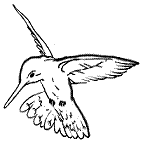 |
| Notice how the uniform lines of the humming bird on the left keep it from looking as dynamic or as dimensional as the drawing on the right with its varied line qualities | |
LINES CAN CONVEY INFORMATION
Map lines are readily recognized as a symbolic representation of a roads and rivers. |
 |
| Lines also communicate emotion and states of mind through their attributes. | |
| Edvard Munch "The Scream" |
LINE ASSIGNMENTS
| Create and label a variety of lines (at least 10) on separate 2" rectangles cut from Bristol board and glue them into your sketch book. For example: |
|
| Diagonal lines |  |
| Horizontal lines with an implied line |
|
| Curved lines showing softness |
|
Assignment for Homework
Lines exist in nature as structural features such as branches or rock layers, or as surface design, such as striping on a zebra or a seashell.
Take your digital camera (cell phone, iPod, Canon PowerShot) outside and photograph some lines in your surroundings… obvious lines… inspiring lines… just lines. Take shots of some “natural” lines… and some “manmade” lines. Back “home” review your images and select the “best” two to four images. Print them out and glue them into your sketch book.
Title the images “Lines” ...plus anything else you might want to add to the title.
Did Paul Klee, in 1922, foretell the existence of Twitter?


